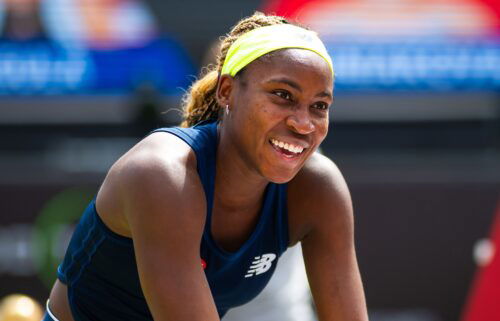When the US Grand Prix was staged in a Las Vegas parking lot

Las Vegas is home to high rollers and risk takers — but when Formula One rode into America’s playground in the early Eighties, the stakes got even higher.
For two strange seasons, in 1981 and 1982, the world championship was decided by the Caesars Palace Grand Prix.
It sounded opulent and grand and, for once, the roulette tables weren’t the only fortune-makers — or fortune-breakers — spinning round and round the famous hotel and casino.
“It was great to be in Vegas,” America’s 1978 F1 world champion Mario Andretti tells CNN. “Because of what Vegas has to offer as far as extravagance outside the race.
“It became a nice event per se because of all the amenities that the city has to offer.”
Hot, hedonistic and high-flying, there was plenty to entertain the traveling F1 community as they arrived in Vegas after a long and fractious season on and off the track.
The teams were booked into Caesars Palace Hotel where they could lounge by the pool or gaze into the mirrored ceilings above the beds.
Hey Big Spenders
The latest edition of grand prix racing in the United States was also aiming to reflect some of Vegas’ other charms as John Watson, who drove for McLaren in both events, explains.
“Part of the reason why Formula One visited Las Vegas was because Vegas is a big sports town, primarily boxing,” Watson tells CNN. “There’s a huge amount of gambling that goes on behind boxing events that take place in Las Vegas.
“The concept between the city fathers of Las Vegas and [former F1 supremo] Bernie (Ecclestone) was ‘here’s a great sport, it has a global television audience and it’s going to pull in the high rollers.’
“The purpose of having F1 in Las Vegas was primarily to attract the the big spenders to come to the Grand Prix and spend their money in the casinos.
“And never forget that Las Vegas is about one thing and one thing only — that’s the casinos.”
In a travel documentary hosted by Australian broadcaster Clive James, which followed the ’81 edition of the Caesars Palace Grand Prix, then reigning world champion Alan Jones admits to “having a flutter on the tables” and losing $1500.
In his biography, written by Susan Watkins, Ecclestone was also said to have handed over “a large paper bag full of $100 bills” to settle his gambling debt.
So, did the drivers, risk takers by nature, succumb to the temptation of gambling?
“Yes, yes, yes, of course!” says Andretti, with a bubble of laughter. “We would be out there trying to sell everything that we had to try to become multi-millionaires.
“There was always chat about that: ‘Oh yeah I won or lost 25,000, 30,000 dollars’ that type of thing.”
“The ones that lost would never admit it, only the ones that won a few dollars would brag about it,” adds Andretti, before breaking off into more laughter.
Watson, however, did manage to avoid the temptations of the Las Vegas gaming tables.
“I gamble on the race track,” the Belfast-born racer said succinctly.
Dizzying ups and downs
But the temporary street circuit set up for the Caesars Palace Grand Prix didn’t quite live up to the opulence of its surroundings.
The grandeur of Caesars Palace, with its frothing fountain and polished Roman colonnades, was swapped for the hot and dusty tarmac of the hotel’s parking lot.
Just over two miles of race track, which switched back on itself like a coiled snake, was squeezed between concrete barriers and high, wire catchment fences.
“It was laid out in what was fundamentally an oversized car park at the rear of the Caesars Palace hotel,” says Watson.
“It was literally an outer loop, then winding its way through that with a series of loops up and down, up and down.
“You had this totally flat ground and three foot high concrete barriers so you had very little sense of reference points. A driver needs reference points around the racetrack, like a building or a tree, to help you find the rhythm of the circuit.
“It was probably the least appealing Grand Prix circuit I think I’ve raced on.”
Hemmed in between the concrete barriers, the anticlockwise circuit also had a bizarre dizzying effect, especially in the Nevada desert heat.
After finishing fifth at the inaugural event, a disorientated Nelson Piquet had to be helped from his Brabham car. During the race he had vomited into his helmet.
In spite of all this, he was crowned the 1981 world champion in Vegas, winning by a single point.
“Unfortunately the two races that I drove there I had the same suspension failure,” recalls Andretti, who raced in both editions, first for Alfa Romeo and then Ferrari.
“Because of the acceleration factor from really slow corners we were getting so much vibration by wheelspin at both events that I had a wishbone failure on the rear and that’s what put me out of both races. So from that standpoint it was not a very sweet memory.”
Watson went into the ’82 Caesars Palace GP as one of a handful of title contenders, but Lady Luck ran out for him too in Vegas.
“The person best placed to win the championship was Keke Rosberg so my task in the race was quite simple, I needed to win the Grand Prix and Rosberg had to finish fifth or lower,” Watson recalls. “That would mean we finished on equal points but I would have won three GPs to his one.
“In the end I finished second and Rosberg was fifth so I didn’t win the World Championship — and Rosberg did.
“It [Vegas] might have been strange for competitors but what a great way to finish a championship year with the last race going down to the wire.”
The race also marked the end of Andretti’s F1 career, which was bookended by a sensational U.S. Grand Prix debut at Watkins Glen in 1968 and his Vegas swansong.
Watson would earn his last F1 win on U.S. soil at the United States GP West at Long Beach the following season.
After the ’82 title showdown, Vegas dropped off the F1 calendar. The Caesars Palace circuit was reconfigured as a modified oval and Andretti would win there as an Indy Car racer.
In 1984 Andretti was crowned series champion in Vegas after finishing second in what would be the parking lot circuit’s final race.
Vegas street race
“Overall Vegas wasn’t all that bad,” says Andretti. “But I didn’t think the track itself would have a long life because it was too short, as we call it Mickey Mouse, because the type of real estate they had there was limited.”
Andretti, rated as one of the all-round, and all-time, greats of motorsport, has raced cars all over North America.
The Caesars Palace Grand Prix may have a roll of the dice but the 79-year-old still believes Las Vegas deserves another shot at F1.
“I always felt that Vegas could have been a good home for Formula One because of what it has to offer,” says Andretti.
“And if you’re going to have a street race [in America] then Vegas could have been one because of the wide boulevards. The international contingent that comes to all these races would look forward to that.”
F1, now under the leadership of its American chief executive officer Chase Carey, is understood to be in talks about a possible future return to Las Vegas.
But a return to the circuit in the Caesars Palace parking lot is unlikely — it was turned into a shopping mall.


